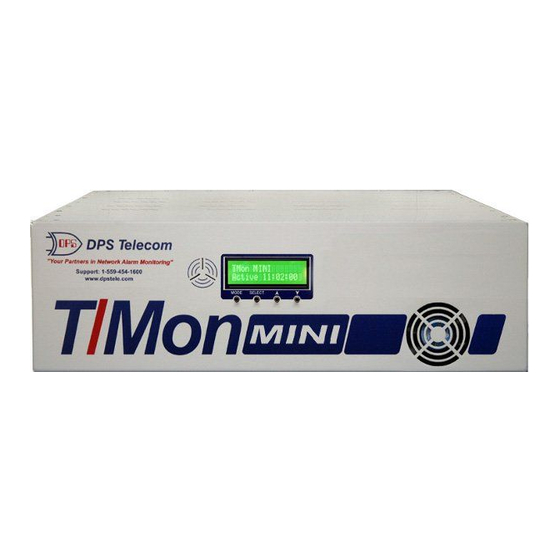Advertisement
Quick Links
Problem: Unable to Setup a NetGuardian to be Polled by T/Mon
Platform: NetGuardian & T/Mon NOC/SLIM
Setting up T/Mon to poll a NetGuardian is a common and
important part of new RTU deployments. If T/Mon can't poll
your remotes, you don't have the visibility you need to do
your job.
Use the following "techno knowledge" paper to setup T/Mon
to poll a NetGuardian and troubleshoot common issues.
This "techno knowledge" paper can help you if:
• You are unable to setup your T/Mon to poll a NetGuardian.
(for more details, review the troubleshooting checklist, starting on page 2 of this guide)
Quick Reference Chart
Advertisement

Summary of Contents for DPS Telecom T/Mon NOC
- Page 1 Problem: Unable to Setup a NetGuardian to be Polled by T/Mon Platform: NetGuardian & T/Mon NOC/SLIM Setting up T/Mon to poll a NetGuardian is a common and important part of new RTU deployments. If T/Mon can’t poll your remotes, you don’t have the visibility you need to do your job.
- Page 2 Trouble Shooting Checklist: T/Mon Edit Procedure From TMon Edit, check the All box in the top right corner of the options menu. Select Remotes >> LAN-based Remotes >> Your Device Fill in the NetGuardian Definition screen appropriately for the NetGuardian you are setting up. NOTE: The Base Address field should match the Unit ID number on the NetGuardian...
- Page 3 Select your device in the Device menu Enter the firmware version currently loaded on your NetGuardian Enter the Address Defaults settings (see page 7-11 in the T/MonXM User Manual for details)
- Page 4 Select the Displays tab in the device menu. This screen shows all display points and descriptions. Double click the Discretes (Display 1) description to view the discrete alarm inputs. Input data for your discrete alarm points similar to the example screens below (refer to page 7- 13 of the T/MonXM User Manual for details):...
- Page 5 Trouble Shooting Checklist: T/Mon Procedure From the Master Menu of the T/Mon select the ‘Parameters’ option. This will open the Parameters Menu. From the Parameters Menu select ‘Remote Ports’. This will put you in the Remote Parameters mode.
- Page 6 NOTE: The steps in this box are only necessary if this is the first time your are setting up your T/Mon to use a LAN connection The Remote Parameters screen will default to the last port that was being edited. To find Port 28, press the ‘F’...
- Page 7 Use the ‘TAB’ key to select the “DCP(F) INTERROGATOR” and press ‘Enter’. Set each field to the value that appears in the screen capture below: NOTE: After filling in the fields, you should see a <No Data Connection> message.
- Page 8 Press ‘F6’ to reach the Data Connection screen Press ‘F1’ to reach the Ethernet TCP Port Definition screen. Use the ‘TAB’ key to select “UDP”. Set the TCP port to the same port number that you chose when configuring the NetGuardian (default is 2001).
- Page 9 Select ‘Windows’ from the menu to reach the Window Definition screen. From the “Window Definition” screen, you can set up an alarm window to send your NetGuardian’s alarms to later in this procedure. To do so, simply move to the end of the list and enter a new name and description for your new alarm window.
- Page 10 Your NetGuardian should now be correctly set up within T/Mon. To verify that your NetGuardian is being correctly polled by T/Mon, you may wish to perform the check described below: From the Alarm Summary screen in Monitor Mode, press Shift+F6 to reach the Site Statistics screen Adjust view to NetGuardian polling leg.















Need help?
Do you have a question about the T/Mon NOC and is the answer not in the manual?
Questions and answers